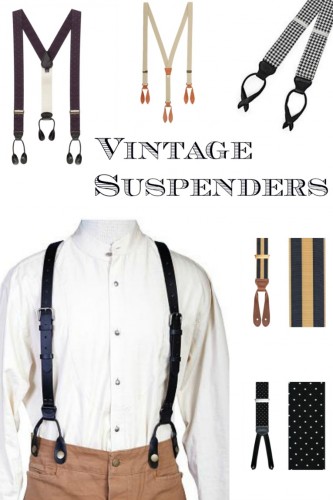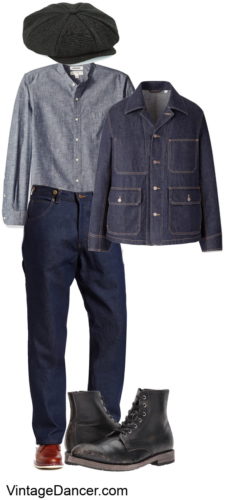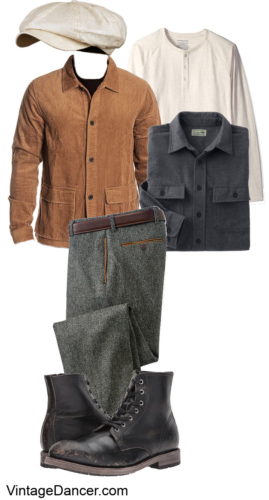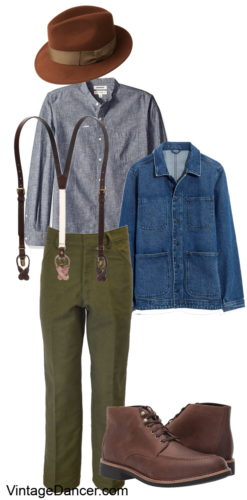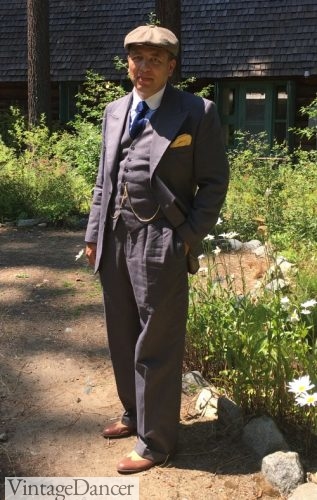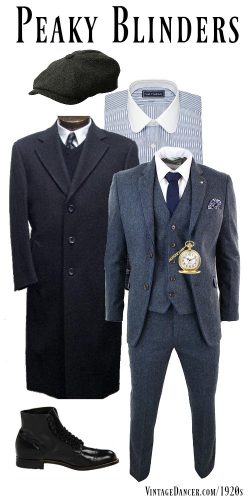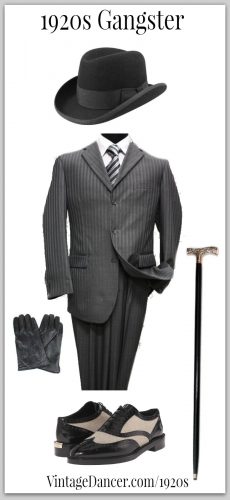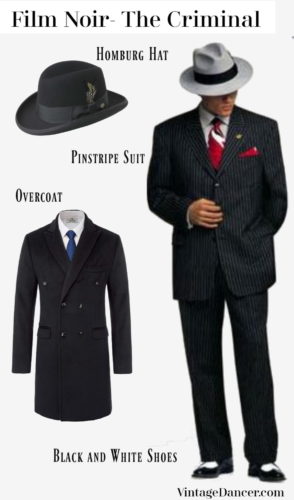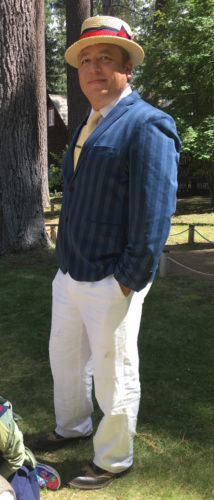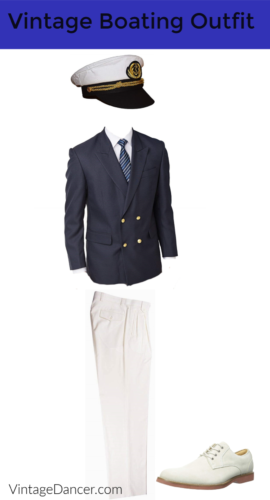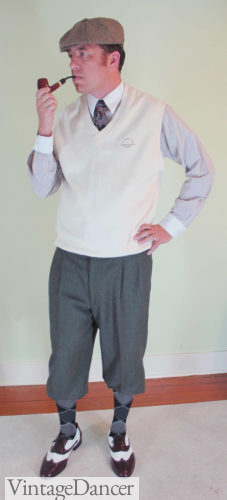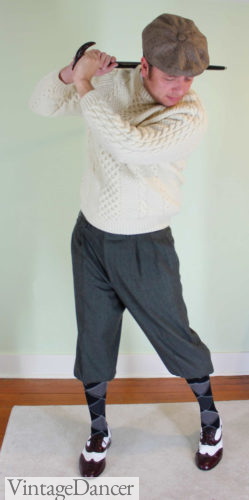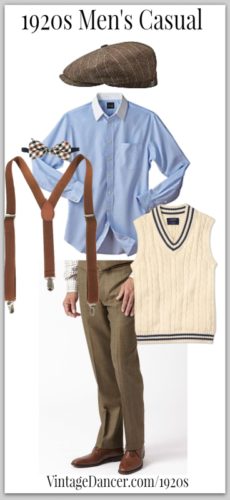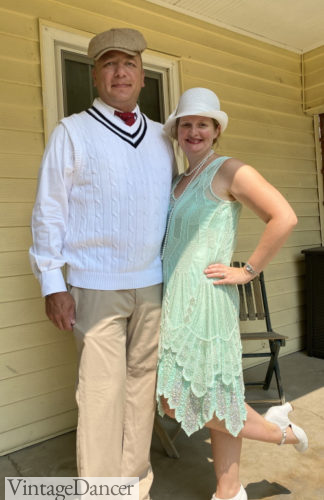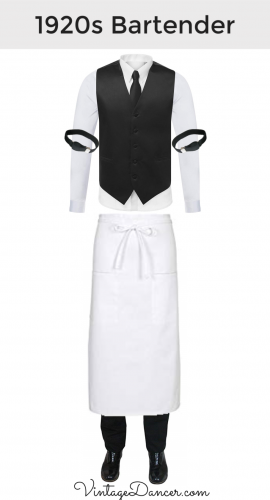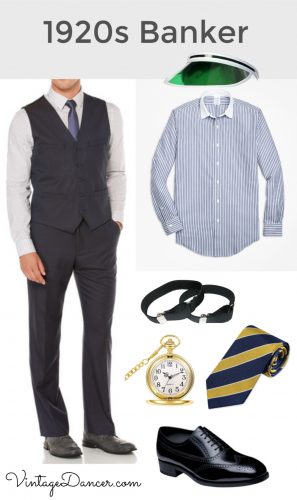So, you have a prohibition era 1920s event to dress up for and you don’t know what to wear? Here are 10+ men’s 1920s costumes and outfits you can make from clothing you may already have or can attain from a thrift store, new clothing store, or online retailer. How “easy” it is will depend on what you can find and how much you want to spend. Accuracy will also cost more than using current trendy fashions.
Unfortunately, there is not a single store that carries these 1920s men’s costumes as complete outfits – instead, you may need to piece together the outfit from multiple retailers. We collected these costumes over a few years of looking, so don’t be dismayed if you can’t find the “perfect” look the first time out. If you need help with your 1920s outfit, just ask us!
For easy 1920s women’s costumes, look here.
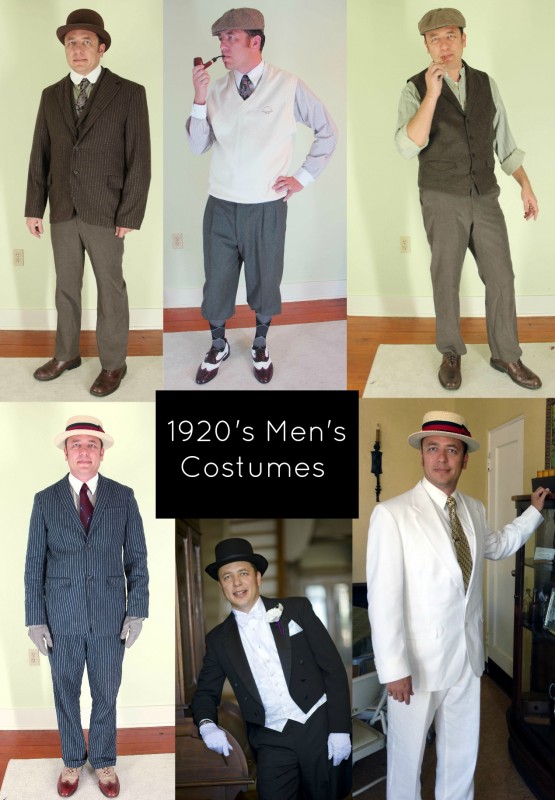
1920’s Men’s Costumes
1920s Working Class Men’s Costume
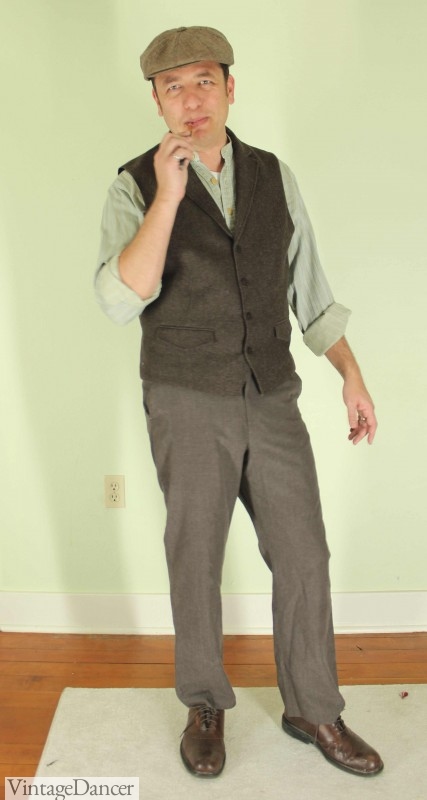
A casual or working-class 1920s men’s costume using thrift store clothing: flat front wool pants, wool lapel vest, collarless green shirt, newsboy cap and brown Oxford shoes.
One of the easiest 1920s looks is a working class or casual men’s style. Poor or working class men couldn’t afford fancy three-piece suits, nor were they practical in labor intensive jobs. These men simply wore a pair of pants, suspenders, vest, shirt, shoes, and hat. Colors were a bit drab in brown, grey, and navy blue. Texture was a big thing in the ’20s, so most materials were a rough wool or thick tweed. The fabric had a defined pattern, too, such as plaid, stripes, and herringbone.
When shopping for 1920s pants and trousers, you will want to find flat front, high-waisted pants (skinny fit and low waist pants are not accurate, but you can use them for a 20s inspired outfit). The early ’20s had a classic width leg, while the mid and late ’20s had a very wide leg. Wide legs will be harder to find with flat fronts. To get a higher waist, purchase pants one or two sizes up and use your suspenders to hold them up (button-on suspenders are best). For that extra ’20s touch, cuff your pants legs 2-3 inches (not shown here). Common colors were blue, brown, and grey. In a pinch, you could also wear dark denim blue jeans as a workwear look.
Next, add a coordinating vest. It doesn’t have to match, but it should be in the same color family. 1920s vests had lapels and usually buttoned up high on the chest. Shop for 1920s style vests here.
The shirt can be solid blue, grey, white or a striped, colored dress shirt with or without a collar. Any dress shirt you already have will work fine or a two pocket flannel shirt. Roll up the sleeves for that working-class touch. A collarless or mandarin collar shirt will make you look like you couldn’t afford a detachable white collar and is also very period-appropriate. A Henley white shirt peaking out from under your overskirt will look like vintage undershirts. Shop shirts.
If you want to wear a necktie, go ahead. Working-class ties were thin strips of fabric or hand-knit ties. Both are popular styles right now, so they will be easy to shop for.
Your shoes should be basic, plain, lace-up Oxfords in brown or black. Lace-up boots would be great, too. A cap toe was the most common detail on shoes at the time. A working-class man couldn’t afford fancier wingtips or two tone shoes. Buy 1920s style men’s shoes here. Learn about 1920s men’s shoe history here.
The 1920s style cap is a must for your costume. The style at the time is what’s called an 8-panel cap or newsboy cap today. It’s not sleek and form-fitting like the ’30s styles — instead, it is wide and floppy. Common fabrics were tweed, textured wool, felt, leather, and corduroy for winter, linen or cotton in summer. A beatup fedora is also workwear/casual fashion. Buy 1920s style hats and caps here.
More 1920s men’s workwear clothing history or buy vintage style casual and workwear clothes.
- Denim on denim workwear
- Fall fashion mix- Wool pants, flannel shirt, cord jacket, Henley undershirt, cap, boots
- Everyday workwear or casaul- chambray shirt, denim chore jackets, wool pants, suspenders, fedora hat, boots
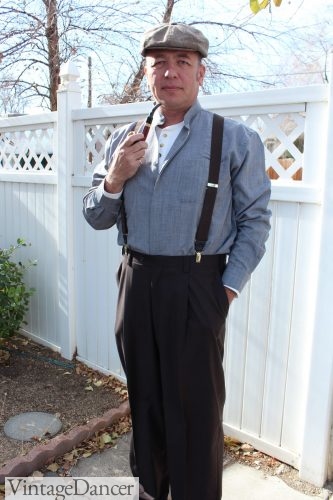
Workwear/casual inspired style. See more here.
1920s Business Class Men’s Costume
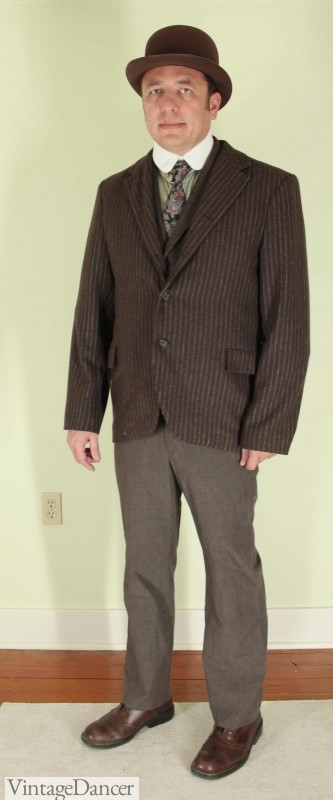
Middle-class business suit with brown pants striped brown suit jacket with a brown vest, white club collar green dress shirt, brown bowler hat, paisley tie, and brown cap toe shoes.
A step above the working-class man is the business class man. He is nicely dressed with an affordable suit that may be a few years old but not out of date. Early ’20s suits were part of the skinny “jazz look” made of neutral, plain colors, while mid to late ’20s suits had wide leg pants, wide lapels, and a wider range of colors and distinct patterns.
Suit: A matching 2 or 3 piece suit is ideal, but if you can’t get one, then choose at least pants and a jacket that are the same color (all brown, all grey, all blue etc). Both single and double breast suits were popular. In this picture, the pants are flat fronts from the ’70s, and the jacket is a brown and white striped wool. Underneath is the same brown vest from the above costume. Ideally, a 1920s suit should be a 3 or 4 button up suit jacket, but the striped pattern is an ideal ’20s pattern so the two-button will suffice. Browse new 1920s style suits here.
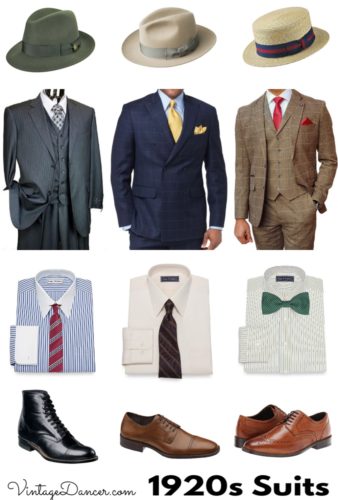
1920s mens suit, hat, shirt, tie and shoe combinations – mixing suit, shirt and hats colors was more fashionable than an all matching set.
Shirt: The shirt we used is a subtly striped dress shirt with a detachable white club (round) collar. A solid pastel shirt would be acceptable, too, but thin vertical stripes were the “in” thing to wear. An attached white pointed collar shirt will be easier to find. A solid-colored collar shirt is also OK for the late ’20s look. White dress shirts were uncommon in the 1920s – color was in! Learn about men’s shirts and where to buy detachable collars. Buy 1920s style shirts here.
Tie: A necktie in paisley, small patterns, or horizontal wide stripes is the semi-formal tie option. A bow tie is also another fun and period-correct alternative. Wear a polka dot tie for something unique and very ’20s. Learn about and shop for men’s ties.
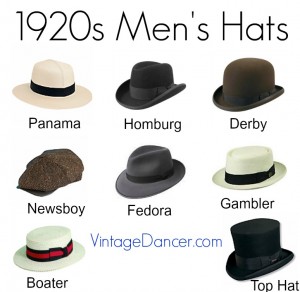
1920s Men’s Hat Styles
Hat: Several kinds of hats can be worn by business class men. The Bowler or Derby (pictured) was a carryover from the previous decade. It’s most noteworthy fan was Charlie Chaplin. Men also wore high crown fedoras, rolled edge Homburgs and straw hats like the Boater, Skimmer or Panama in the summer. Young men sometimes paired caps with their suits instead of felt hats. Learn about men’s hat styles here.
Shoes: A brown suit needs brown lace up Oxfords shoes or boots. A grey or navy suit needs black Oxfords. Cap toes or wingtips are a good and versatile men’s shoe. Two-tone brown and white shoes were very trendy for any color of the suit. Black and white two-tone shoes were not quite in style yet, but will be easier to find today. Learn about 1920s men’s shoe history.
1920s Men’s Upper Class Suit / Gangster/ Bootlegger Suit
- Our Peaky Blinders outfit
- Peaky Blinders outfit
For the well-to-do man, like the Great Gatsby, Al Capone or the Peaky Blinders and his band of bootleggers, a complete head to toe look is important. They were the fashion leaders of the day. The black striped suit or “zoot suit” that has become associated with the gangster look that was invented by Hollywood. In reality, wealth men did wear striped suits, but they were never black and “Zoot suits” didn’t appear until the 1940s.
Suit: Striped or plaid suits in brighter colors started to appear around 1923-4. They can be a challenge to find today but are well worth it when you find one. We found ours made by Perry Ellis. It is a linen blue with white shadow stripes (wider than pinstripes). 1920s stripes and plaid should be noticeable, not subtle. Single- or double-breasted styles are both common. Pants should be flat front, not pleated, and cuffed at the ankle. Buy new 1920s style suits here.
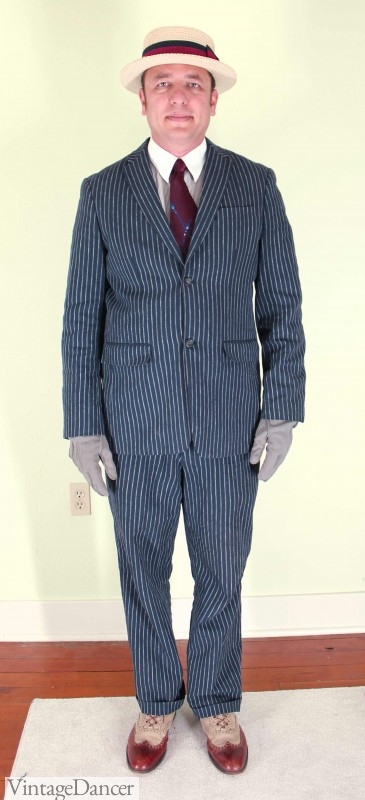
Upper-class men’s costume or gangster outfit with a striped blue suit, wingtip shoes, boater hat, gloves, white-collar shirt and tie.
Shirt and tie: Same as above costume- striped or pastel shirts with white collar. This time add a coordinating pocket square to the jacket (we forgot to do this!) Another thing we could have added was a collar bar.
Hat: For this summer look we put on a straw boater hat, which was very popular for spring and summer. A straw Panama hat is another wealthy man’s summer hat. For a casual look, a white 8 panel cap would also look well. For the fall/winter, wealthy men wore a dark-colored fedora or Homburg hats. Not black — dark blue, green, brown, and grey felt hats are period correct and look very vintage.
Shoes: Now you can bring out your two tone shoes. Wingtips, saddle shoes, or cap toes with brown and cream patterns all work well. Black and white was less common. Otherwise, a solid pair of black or brown wingtips will look dapper when worn with a pair of white shoe spats, too.
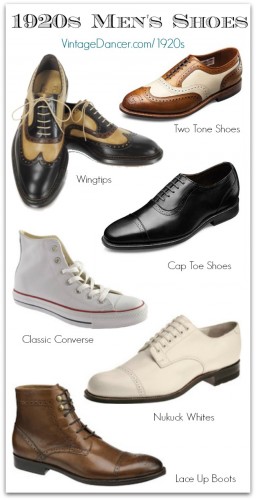
1920s Men’s Shoe Styles
Accessories: Gloves in a color to complement, but not necessarily match, the suit is an appropriate addition. A pocket watch on a chain clipped to the vest pocket or buttonhole is a popular accessory, and a walking cane is an upper-class accessory that will set you apart from the business class men. Buy 1920s men’s accessories here.
If you insist on wearing the Hollywood gangster look, you can find plenty of choices in the 1920s men’s costume section.
- 1920s Authentic Gangster outfit – Black homburg hat, dark grey striped suit, two tone shoes, leather gloves and a walking cane (or is it a weapon?)
- 1920s Hollywood gangster outfit: homburg or fedora hat, black pinstripe suit, black overcoat, black and white wingtip shoes or spats
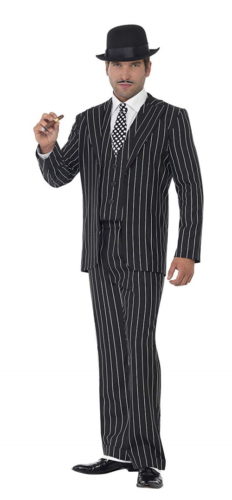
Gangster Costume- Shop here.
The popular British series Peaky Blinders has revived a new 1920s gangster look using mostly tweed fabrics instead of the gangster stripes. Both blue-grey and brown tweed suits and separates in a skinny fit is a blend of 1920s and 2010s fashion. Instead of Oxford shoes, lace-up boots are now in fashion, newsboy caps are back in style, pocket watches are a must-have accessory, and tweed-y fabrics are selling fast. Learn more about creating a Peaky Blinders outfit here.
1920s Men’s Summer Suits
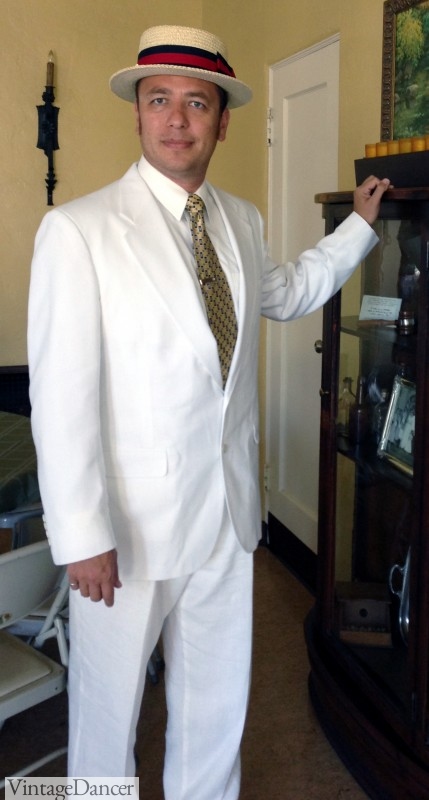
White Summer Suit
For upper class men in summer, white was the color to be seen in. White or ivory was worn at garden parties, summer house parties and at outdoor sporting events. It is a popular option for warm-weather events, beach weddings and even formal galas where you want to stand out from the sea of all black. Other summer outfits were striped seersucker suits or a striped boater jacket over white pants. More on these outfits below.
White Suit:
Suit: A white or ivory linen suit is nice and cool in summer. We found this white poly-blend dinner jacket-less prone to wrinkling than pure linen. A white dress shirt and summery gold tie complete this easy look above. In the summer outfit below, we opted for a pink shirt with white club collar (Jay Gatsby wore one) and clip-on suspenders (not accurate but easier).
Hat: Again, straw hats are a must in spring and summer. Here we used our straw boater again. Good Panamas are quite expensive. We have gone through a few cheap ones fast. Don’t skimp if you can afford it.
Shoes: White suits need white shoes. In the 2013 The Great Gatsby movie, Jay Gatsby wore grey and white two-tone shoes with his look. While I have never seen this option elsewhere, I believe it is period correct. In the look below, we used vintage brown wingtip shoes which work perfectly with the outfit and are easier to keep clean.
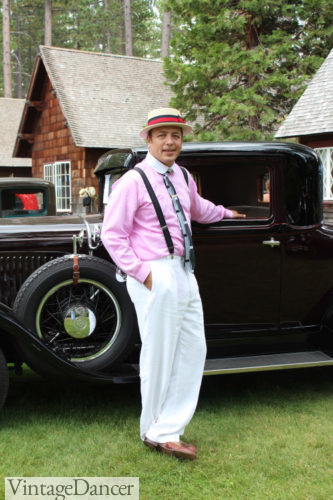
1920s summer outfit- White pants, two tone brown shoes, pink shirt with white collar, suspenders, Art Deco tie, and straw boater hat
Seersucker Suit
The seersucker striped suit goes back to the early 20th century but remained popular well into the 1920s. The lightweight cotton seersucker material was perfect for summer suits. The small blue and white, grey and white, and even pink and white stripes fit right into the colorful patterns of most 1920s menswear.
For our seersucker costume, we choose a double-breasted suit with a matching vest. A single-breasted suit would have also been perfect for this ’20s look. We added a pink shirt with a white collar (a great combination!) and a blue bow tie, two-tone shoes, a straw boater hat, white gloves, and a walking cane. Snazzy! Oscar ALWAYS gets a lot of compliments wearing this outfit.
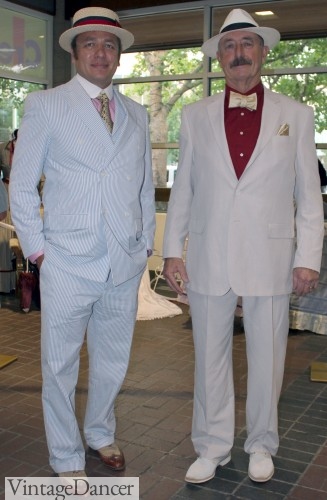
Seersucker suit on the left; Ivory linen suit on the right. Both are perfect for hot summer events.
Boating Attire
A common alternative to a full striped suit is to wear a striped jacket/blazer over white pants. The jacket could also be a navy blazer worn with a captain cap. It was a signature yachting uniform, college sports team uniform (such as rowing), cruising attire (as in taking a cruise across the ocean) and a popular costume for barbershop quartets/ragtime musicians. A white dress shirt, summer necktie or bow tie, and straw hat keep this look semi-formal. For a slightly more casual take, wear a striped vest instead of the jacket, with a bow tie and sleeve garters.
- 2019 Oscar’s Boating Outfit – Striped boater Jacket with White Pants and Hat
- Classic boating/yachting outfit
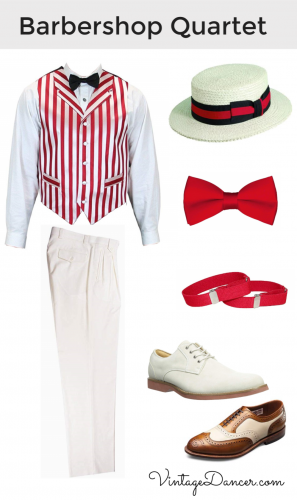
1920s barbershop quartet outfit with striped vest and matching accessories
1920s Casual Outfits – Sporty
“Casual” and “1920s” don’t belong in the same sentence, at least not in the way casual clothing is understood today. Short sleeved shirts were very rare, jeans were only for workwear, and shorts did not exist, but the 20s did have its own version of casual clothing, which was more widely known as sportswear. Whether playing a sport or just dressing like they were going out to play, men turned to these more comfortable dressed down looks for weekends.
Knickers
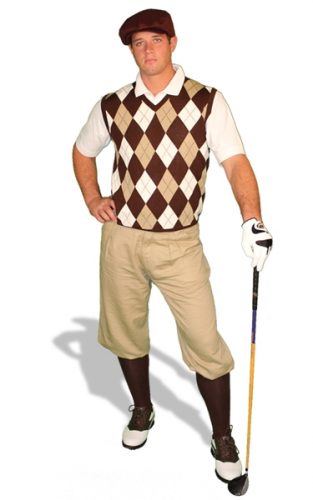
1910-1930s Golf Attire with knickers pants, sweater vest, tall socks, golf cap, and two tone shoes.
Golf, tennis, hiking, hunting…. any kind of sport in the 1920s had its own fashion. In the 1920s, most sports and casual sporty outfits embraced cropped pants called plus fours. They are similar to knickers, except you don’t see the cuff band around the knee because the pant leg bags over it 4 inches (or more). A similar pant style was the Jodphurs. They were worn while riding horses, hunting, hiking, and for certain uniforms like a chauffeur, movie director, or the military. They were banded just under the knee so that tall boots could be worn over the cuff.
While you can buy new golf knickers, it’s easy enough to make a pair. The simplest technique is to buy a pair of wide-leg pants and either pin or sew on elastic to the cuff, then pull it up to your knee like we did here:
- Golf outfit with sweater vest
- Golf Outfit with Cable Knit Sweater
Next, add a pair of tall argyle socks (or any geometric pattern) and some two tone Oxfords. Bring back your newsboy cap from the working-class look and you are now in the upper-class golf league. This look also works for newsboys, teens and other casual men’s occupations or hobbies.
For your top, you can wear either a chunky cable knit sweater or a button-up dress shirt and pullover knit vest with a shirt and tie. Vests were either solid colors or crazy patterns, like argyle and Fair Isle. The sporting look is one style that loved to combine mismatched patterns, colors and textures. Have fun, be wild and crazy and you will look the ’20s part.
Instead of knickers or plus fours, you could create a typical casual look with long pants, a dress or workshirt with the sleeves rolled up, a newsboy cap, suspenders, a bow tie, and an optional sweater vest or button vest. Pants and vest don’t need to match for a casual look. Ideally, suspenders should be button-on instead of clips. You could also wear a thin leather belt, but DO NOT wear a belt and suspenders at the same time.
- Many costume options from ’20s style clothing
- Prince Naveen from Disney’s Princess and the Frog
1920s Tennis Outfit
Another popular sporty summer look is a 1920s men’s Tennis outfit. By wearing white pants, a white shirt, and white shoes (canvas high tops or leather Oxfords) with a tennis/cricket/varsity cable knit sweater, you will be both comfortable and fashionable. This is a popular couple’s costume too. Learn more about tennis outfits here.
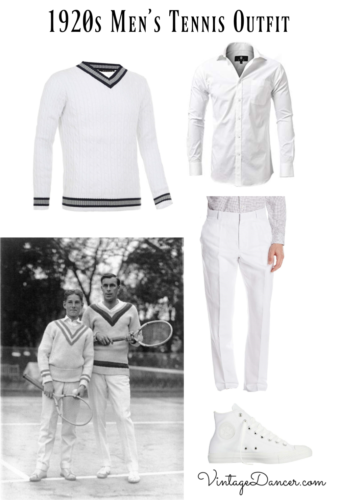
Men’s tennis outfit
1920s Swimwear
If you really want to be bold, consider wearing a 1920s men’s swimsuit / strong man costume here.
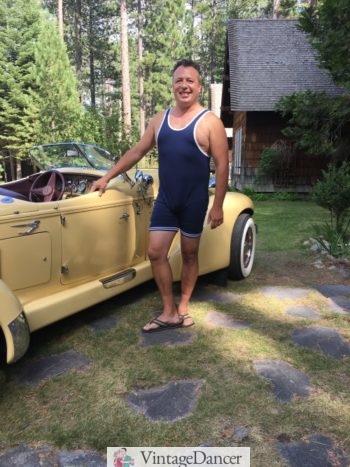
Oscar’s wrestling suit doubles as 20s/30s swimsuit or strongman costume
1920s Men’s Formal Suit
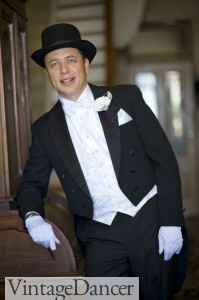
1920s white tie formal suit
For an after-6pm dinner party, evening at the opera, or groom’s wedding attire, dressing in men’s white tie suits was a requirement. Black tie was a semi-formal look acceptable for immediate family dinners, and among upper-middle-class men. White tie means the vest and bow tie are white while black tie means a black vest and bow tie was worn together. Black or white tie was also worn by waiters, bartenders, and nightclub party-goers at upscale establishments.
The picture above was taken for our 1890s themed wedding. Men’s white tie formal wear remained unchanged through the early ’20s. The mid ’20s saw more men wearing the casual dinner jacket, called a tuxedo today. The variations between tuxedos back then and now are minimal. If you have a tuxedo in your closet, by all means, wear it or rent one locally.
Learn the history of men’s formalwear here and how to pull off the 1920s look using modern tuxedos here:
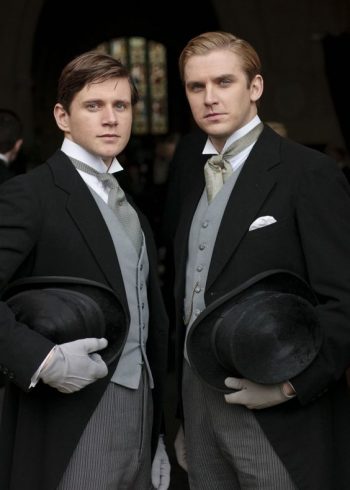
Morning suits are worn by the dapper men of Downton Abbey to a wedding
Another formal suit was the traditional morning suit. It was worn by upper class gentlemen and important chaps like senators and prominent businessmen, as well as comedian Charlie Chaplin. It was also typical groom attire for 1920s weddings, which took place in the morning or early afternoon. Men who had the budget to buy or borrow a morning suit would wear it on their wedding day, along with groomsmen and fathers.
What is a morning suit? A pair of high waisted grey and black narrow striped pants were worn with a white wingtip collar dress shirt, cravat tie, vest (grey or black), morning coat, white or grey gloves, white pocket square, black patent leather shoes, white spats (optional), black top hat, and a cane. It is a very regal outfit. It is not surprising that men are opting to wear this traditional wedding attire over a tuxedo again today. Learn more about men’s wedding attire here.
To get this look, you might be able to rent a complete look, otherwise there are a few choices online. The best selection is in the UK, where the morning suit is still worn to high fashion events like Ascot and royal affairs. Shop morning suits here.
What NOT to wear to a formal event: Velvet tuxedos, tuxedo jackets with contrasting lapels, all-white tuxedos or any color other than black or dark navy blue, cummerbunds, pleated tuxedo shirts, sneakers/loafers/not black shoes. The 1920s were very strict about formality. It will be expensive to be accurate, so do your best within your budget.
More men’s 1920s Outfits
Learn more about creating these 20s outfits:
- 1920s Bartender Attire
- 1920s banker, teller, accountant, clerk or professional men’s outfit
Even more 1920s men’s outfits
- 1920s Men’s Outfit Inspiration & Costume Ideas \ Roaring Twenties
- Accurate 1920s Classic Car Show Costumes
- Men’s Vintage Gym Clothes 1920s to 1960s
Debbie Sessions has been teaching fashion history and helping people dress for vintage themed events since 2009. She has turned a hobby into VintageDancer.com with hundreds of well researched articles and hand picked links to vintage inspired clothing online. She aims to make dressing accurately (or not) an affordable option for all. Oh, and she dances too.
